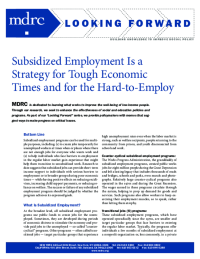Subsidized Employment Is a Strategy for Tough Economic Times and for the Hard-to-Employ

Bottom Line: Subsidized employment programs can be used for multiple purposes, including: (1) to create jobs temporarily for unemployed workers at times when or places where there are not enough jobs for everyone who wants work and (2) to help individuals who face barriers to employment in the regular labor market gain experience that might help them transition to unsubsidized work. Research to date suggests that subsidized jobs can provide short-term income support to individuals with serious barriers to employment or to broader groups during poor economic times — while having positive effects on reducing recidivism, increasing child support payments, or reducing reliance on welfare. The success or failure of any subsidized employment program should be judged by whether the program achieves its expressed goals.
What Is Subsidized Employment?
At the broadest level, all subsidized employment programs use public funds to create jobs for the unemployed. Sometimes, they are developed during periods of economic distress to stimulate the economy and provide paid jobs to the unemployed — so-called “counter-cyclical” programs. Other programs — often called transitional jobs — target particular groups that experience high unemployment rates even when the labor market is strong, such as welfare recipients, people returning to the community from prison, and youth disconnected from school and work.
Counter-cyclical subsidized employment programs: The Works Progress Administration, the granddaddy of subsidized employment programs, created public works jobs for eight million people during the Great Depression and left a lasting legacy that includes thousands of roads and bridges, schools and parks, even murals and photographs. Relatively large counter-cyclical programs also operated in the 1970s and during the Great Recession. The wages earned in these programs circulate through the system, helping to prop up demand for goods and services. Such programs also allow workers to keep exercising their employment muscles, so to speak, rather than letting them atrophy.
Transitional jobs (TJ) programs: These subsidized employment programs, which have operated sporadically since the 1970s, are smaller and target particular groups that face barriers to entering the regular labor market. Typically, the programs offer individuals a few months of subsidized employment at a nonprofit organization or, less commonly, in a private business that agrees to hire them. While the workers are in their temporary job, the programs often provide support services and try to help them find more permanent jobs. TJ programs put wages into people’s pockets, but that is not their main goal. They use subsidized jobs as a tool to build skills and prepare hard-to-employ individuals for success in the regular labor market. They operate on a simple premise — that the best way to learn to work is by working — though the programs are far from simple to operate.
What Do We Know?
Unemployment remains high for many disadvantaged and displaced groups. While the national unemployment rate has declined to 4.7 percent after a long, slow recovery from the Great Recession, the jobless rate is much higher for teenagers, individuals with criminal records, workers without any postsecondary education, African-Americans, and other groups that have difficulty finding jobs even when economic conditions are good. Subsidized employment strategies can provide people with immediate income, help reduce the “scarring” of long-term unemployment that may hurt people’s job prospects, and aid the hard-to-employ in gaining work experience. They can also produce goods and services that provide value to society at large.
TJ programs effectively increase employment in the short term. But more must be done to improve longer-term employment outcomes for people with serious barriers to employment. Studies show that several TJ programs for former prisoners and welfare recipients generated very large increases in employment initially — due to the subsidized jobs themselves — suggesting that the programs succeeded in employing many people who would not otherwise have worked. However, the TJ programs tested thus far have generally not improved long-term employment outcomes (the more intensive National Supported Work Program for welfare recipients tested in the 1980s being the lone exception). New studies are testing the next generation of programs.
TJ programs targeting people recently released from prison can reduce recidivism (the rate at which they commit new crimes or are re-incarcerated). The Center for Employment Opportunities generated decreases in recidivism over three years, a rare achievement resulting in as much as $8,300 in savings to taxpayers for each program participant. New findings from a national demonstration show that two of three TJ programs targeting recently released prisoners also reduced recidivism. However, a study of four TJ programs in the Midwest that targeted recently released prisoners found that the programs did not consistently reduce recidivism — even during the early period when they had a large impact on employment. Researchers are currently working to understand why some of these programs reduced recidivism and others did not.
TJ programs can reduce welfare dependence and increase payment of child support. The Transitional Work Corporation, a TJ program that targeted welfare recipients, reduced welfare receipt and welfare payments. The positive impacts for programs targeting noncustodial parents largely tracked impacts on employment, although coordination with child support agencies and some special child support enhancements contributed to the pattern of effects.
Recent subsidized employment programs have sought to place participants in jobs in the private sector. Many states developed subsidized employment programs under the TANF Emergency Fund. These programs were scaled up very quickly and employed about a quarter million people from 2009 through 2010. Unlike in the past, the largest of these state programs placed most participants in subsidized jobs in the private sector, rather than in public service positions created for this purpose.
What’s Next?
Subsidized jobs programs have had positive effects on recidivism, child support payments, and welfare receipt, and have consistently produced large, short-term impacts on employment, but more work needs to be done to identify models that can improve long-term employment outcomes.
Since the cost savings and public safety implications of reducing recidivism are so great, it may be worth testing new TJ models that are specifically designed to reduce recidivism — for example, programs that combine transitional jobs with interventions designed to address attitudes and behaviors that can lead to crime.
Larger-scale initiatives may be needed as well, particularly for certain groups that have been most dramatically affected by the Great Recession and the slow recovery — for example, non-college-bound young people, whose employment rates have seen a marked decline in the last decade.
For more information, contact Dan Bloom at 212-340-8611 or dan.bloom@mdrc.org.
* * *
This policy memo was supported by the Annie E. Casey Foundation.







